Francesca and Henk-Jan's Backpacking Trip!
Saturday, June 5, 2010
Bohol And Beyond
Our first order of business was checking into a small hotel I found online – which happened to be on an adjacent island which is popular for its beaches and snorkeling: Panglao. This place was actually outside of the city of Tagbilaran which was a bit inconvenient for us considering we decided the mall in the city center was the best place for cheap meals. I didn’t know the hotel wasn’t in the city-center! Vowing to find a place closer for the next night, we grabbed a tricycle and headed into the city. Pizza Hut was a late lunch, and by the time we were finished the tourism office had closed. Instead we headed to a small hotel in the city center we heard of before: Nisa Travelers Inn. They were able to book us a driver with car for the next day for the classic Bohol tour package.
Our driver picked us up early from the hotel to start our day. Henk and I loaded the bags into the backseat of the van and climbed in. We decided to start by driving out to the chocolate hills since they were the furthest out. On the way, our driver stopped by a roadside tarsier enclosure. Now, Henk and I heard these enclosures existed, but we didn’t want to visit one because we thought it wasn’t fair for the tarsiers to support them being so locked-up. We heard that many tarsiers kept in cages simply can’t handle the stress and end up committing suicide by smashing themselves against the cage walls. Instead we wanted to head to the tarsier sanctuary in order to see the little fluff-balls in a more natural environment. However, our driver insisted and we vowed to not purchase anything or pay any fees to the captors… just look at the tarsiers and see what the situation was. And it was just as we feared… those poor creatures (who are nocturnal, by the way) were awake in the day time, opening their eyes at every car honk and rustle of people that came by.
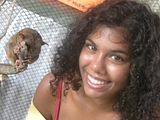
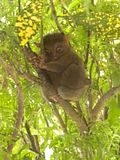
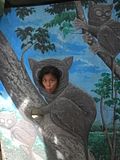

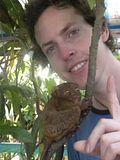
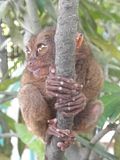
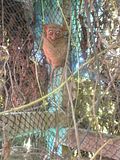
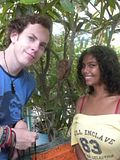
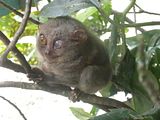
We tried to be as gentle as we could with them, keeping our voices low and our camera off flash. Still our efforts were in vain as the ‘guides’ at the enclosure kept shaking the branches of the trees, waking up the tarsiers. Horrible! We saw a mother tarsier with her tiny baby, and a tarsier that was blind in one eye. Freaky-looking! The next stop for us and our driver was the man-made forest. I think our driver enjoyed this stop a bit more than us, as he commandeered a lot of ‘jumping’ pictures of us in the middle of the street surrounded by… well, it just looked like a regular forest! But apparently the trees around us were actually all planted there as part of a government project. You could kinda tell because the trees were all the same size and seemed to be lined up in ‘rows.’
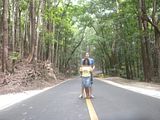
Before we entered the ‘Chocolate Hills Complex’ (a viewing point from which you can take pictures of the hills and buy tons of Bohol junk) I spotted one of the hills I thought looked the coolest. We knew that the hills look ‘the most chocolate-y’ when the vegetation is all dried out in the dry months of April and May. But it was the end of May now, almost June, and the rainy season had just started. Thus I predicted that the result would be ‘half chocolate, half green’ hills. And we actually saw them! One hill literally had one dried-out chocolate looking side, and the other side was already going green. We took pictures of that hill later, first going into the complex. According to a few posted signs, the Chocolate Hills are “…bumps in the earth that have been carved out from the relatively thin layers of coral and shell fragments.” The story goes that, “About two million years ago, the island of Bohol was below a shallow sea. Coral reefs, similar to those now found offshore in Northern Bohol, thrived and extensively covered the sea floor. During stormy days, fragments of corals and shells derived by waves from the reefs were deposited mostly at the landward side of the reefs. The coral and shell fragments formed relatively thin layers (brown) surrounding the live coral reefs (pink). Slowly the land rose causing the coral reef formations to emerge out of the sea. The […] southern sections of Bohol had been uplifted more than the northern sections.” Then this followed by the elements of nature eventually carving out hills.
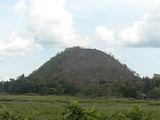
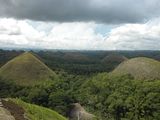
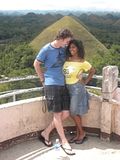
One of the places we were surprised by on our day trip was the butterfly conservation center. We ended up with a very informative guide, who showed us differences between male and female butterflies (the females are much larger as they are dominant) and some inter-sexed butterflies. We held little caterpillars (at first I thought mine was upside down because I thought the hairs on it were its legs!) and saw the process of their transformation. Henk took this opportunity to get some National Geographic worthy butterfly pics! We grabbed some drinks to go before we left, asking our driver to head straight to the tarsier center.
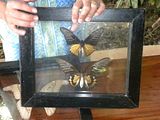
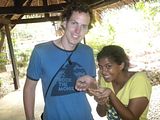

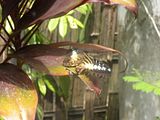
The Tarsier Foundation is a much more reasonable way to see the tarsiers, but since it’s a bit out of the way, most drivers don’t want to take you. But it is worth it! It is much more fun to play ‘find the tarsier’ when they are among trees and their natural environment than it is to witness them scared and sick in their cages on the side of the road. We were led around by a guide who helped us spot them. There was also a nice little display of a tarsier skeleton and a few tarsier facts such as: Tarsier eyes are 150 times bigger than humans relative to body size!
From the Wiki – forgive the length of this quote, I think tarsiers are really cool and you should learn a lot about them!! So here you go:
“Tarsiers are small animals with enormous eyes; each eyeball is approximately 16 mm in diameter and is as large as their entire brain. Tarsiers also have very long hind limbs. In fact, their feet have extremely elongated tarsus bones, from which the animals get their name. The head and body range from 10 to 15 cm in length, but the hind limbs are about twice this long (including the feet), and they also have a slender tail from 20 to 25 cm long. Their fingers are also elongated, with the third finger being about the same length as the upper arm. Most of the digits have nails, but the second and third toes of the hind feet bear claws instead, which are used for grooming. Tarsiers have very soft, velvety fur, which is generally buff, beige, or ochre in color.
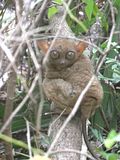
Tarsiers are the only entirely carnivorous primate on Earth: they are primarily insectivorous, and catch insects by jumping at them. They are also known to prey on small vertebrates, such as birds, snakes, lizards, and bats. As they jump from tree to tree, tarsiers can catch even birds in motion.
Gestation takes about six months, and tarsiers give birth to single offspring. Young tarsiers are born furred, and with open eyes, and are able to climb within a day of birth. They reach sexual maturity by the end of their second year. Sociality and mating system varies, with tarsiers from Sulawesi living in small family groups, while Philippine and Western tarsiers are reported to sleep and forage alone.”
Finally we were nearly done. While we were starting to get hungry, we figured we could eat something once the tour was finished back in town. Thus we headed to the Baclayon Church around 12:30 pm. But unlucky for us, it had just closed! We would have to wait an hour in the heat before it would re-open… and there was nothing around for us to do. Since our driver didn’t want to take us anywhere reasonable to get some grub, Henk scored us a hot chocolate, cookies, and some buns that he put peanut butter on for me. Once the church opened we headed inside… and were a bit disappointed. There didn’t seem to be anything too special about the place besides the fact that it is the oldest coral stone Jesuit church in the region. Built in 1727, the Baclayon church does have the face of Padre Pio on the side of it (their special saint) which is a bit random… and looks to be painted on!
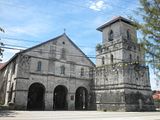
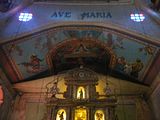
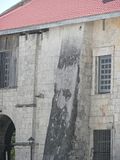
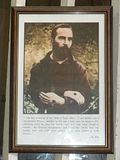
The last stop of the day was the Sikatuna Blood Compact memorial. We later learned from the museum that this memorial represents a deal that was struck in 1565 between the Spanish explorer De Legazpi and local chieftains of Bohol. Legazpi, in attempting to gain control in the Philippines, was attempting to use various tribes’ dislike of Cebu’s leader Lapu-Lapu and form an alliance with them. The chieftains pledged to be ‘blood brothers’ with the Spanish explorer, sharing a cup of wine with Legazpi that was mixed with drops of their blood. After viewing the Blood Compact we headed straight for the National Museum in Tagbilaran City. Here we learned a bit about the history of Bohol, the local wildlife, and more interesting Chocolate Hills facts.
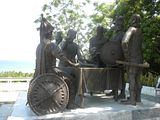
Prince of Persia was our entertainment for the day and Garry’s Grill was dinner. We enjoyed the free Wi-Fi on our laptop, planning out the next few days of travel, while munching on fish sticks. We planned to take the morning ferry from Bohol to the city of Dumaguete on the island Negros Oriental. Crashing in Nisa’s for the evening got us in a prime position to get to the ferry terminal the next morning.
BUT the morning ferry didn’t go as planned. We were early for the ferry, but of course it was late. Furthermore the ferry itself took longer than expected. By the time we got in we were quite exhausted. We headed towards the famed Harold’s Mansion for rest. This hostel turned out to be one of the nicest we had in the Philippines thus far which was a great treat! We checked into our room and Henk had a shower and rested while I went out to walk around town. The long day was getting to both of us and relaxing for the day was a good idea.
I went to a little museum Henk found out about at Silliman Anthropology University mini museum. This museum had old tribal artifacts and pottery, even an example of ‘how to write your name’ in a southern tribal language. I had forgotten to bring the camera with me there, but a few captured phone photos hopefully make up for that. I wasn’t allowed to take pictures in the main part of the place anyways. I did however score a photo of “Lumabat and Mebuyan.” Mebuyan, according to the sign posted in the museum, is the “…Bagobo goddess of fertility and sometimes portrayed as the goddess of the Underworld. When [she] gets mad, she will shake a lemon tree intensely. When a ripe fruit falls to the ground, an old person will die. When a young fruit falls, a young person dies. Lumabat is the god warrior from the sky. He is the brother of Mebuyan and sometimes portrayed as her husband. [He] has no intestine and therefore experiences no hunger pangs.”
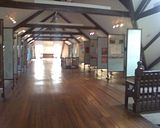
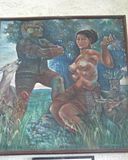
I walked along the pier taking in the city. There was nothing too special about the city itself, but the pier was nice and there were a church which had a burning display outside of it. I grabbed some tricycle transport to Robinson’s Department Store and walked around in the mall a bit. I decided I was on a mission to get a little gift for Henk because he had wanted a music player for quite some time. (We originally brought two iPods on this trip but we sent one home and the other one broke.) We were trying to find something really cheap (read: fake iPod) to hold him over until our trip ends, and I must have tested out half a dozen of them before I found a good one for $30 USD. I brought it for him, grabbed some KFC to eat, and wrote a card to go along with it. He was very happy to get his gift that night!
The next morning we put on our bathing suits and (after a bit of a late start debating what we should do, as we were running short on time) headed for the bus station to go to Apo Island. Off the coast of the main island is a really tiny island with an amazing coral reef and giant sea turtles swimming around it. Henk guesses that the whole island must have been only 4 or 5 square kilometers. We walked to the dock and boarded our very small (and somewhat shady) boat with its captain and deaf first mate and 30 minutes later we docked at Apo. WOW was it beautiful!! OMG! Small, secluded, very deserted of tourists… so nice!
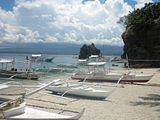
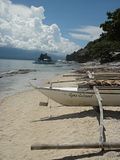
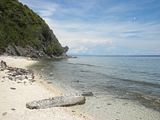
After renting our gear from some locals, we headed down to the water towards the front of the island. We had been tipped off that a bunch of sea turtles were swimming around and we wanted to make sure we’d see one or two! We got what we asked for – must have seen at least 5 or 6 different turtles a bunch of times. I even chased one around for a while, trying to imitate its swimming style. They didn’t seem to mind us getting close to them… Henk even touched one a few times! The water was so clear and the reef was teeming with fish and colorful coral. The first time since Bali that we’ve seen first-rate snorkeling!
Our backpack had been left with a hammock-lounging local, and we thanked him for watching it. Henk grabbed our clothing (which had gotten wet on the boat ride over) from its position drying alongside some locally caught fish and we went to a restaurant we think was called Paul’s. It was after 1:00 PM by now and we’d been swimming for about an hour and a half… starting to get famished! We didn’t expect too much on such a small, secluded island but we were indeed impressed! Henk’s noodle soup and my chicken satay (with home-made bread and hand-cut French fries) didn’t fail to leave us full and satisfied.
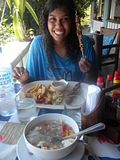
At about 2:15 PM we were back in the water – this time at the Marine Sanctuary on the opposite side of the island. Here the coral was even more spectacular… the formations and colors were so striking! But there weren’t as many fish this time as there were in the morning. We guessed this was because the wind, and thus the waves, had started to pick up in that hour we had eaten. In fact it even started sprinkling rain a bit. We managed to last for an hour of this before we called the day a success and decided to head back. The rocks were extremely hard on my feet so thankfully Henk found me some temporary flip-flops to wear until we got back to our original ones. Thank God for that!
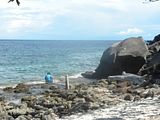
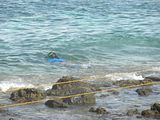
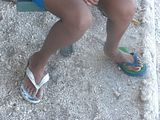
Back on the boat and back on the water. For an hour longer than expected. In the middle of our boat trip back, about 3.5 kilometers into the 7 kilometer journey, the propeller on the boat must have caught on something because it broke. The blade was still slightly spinning, but we weren’t going much of anywhere and the increasingly high and rough waves seemed to be moving us around more than the propeller itself. Our captain and first mate looked at each other worriedly, not leaving Henk and I very comfortable with what could be our future. The captain started bailing water out of our boat (at first we feared we had a leak until we saw the high waves splashing into the boat) and our first mate stood at the front of the boat waving around a bright orange life jacket towards the shore. ‘Please someone spot us!’ we were all thinking. After a while of this, I suggested to Henk that he might want to grab the oar and start paddling… no one was coming to rescue us!

Eventually we must have been spotted because another boat headed out towards us, tossing us a line and dragging our boat back to shore. It was really starting to get rough out there on the sea and we didn’t want to resort to paddling (or worse, swimming!) those 3.5 kilometers back to shore! Our mission was complete at 5:00 PM and we managed to find a jeepney to take us back to the city. That evening we ordered room service (noodle soup and pizza!) since we were quite exhausted and needed a shower more than anything by then. Plus the next morning we planned to leave for the north of the island (an all-day drive! YIKES.) to Bacolod. The trip was quite stressful, I have to stay. It was beautiful, in fact some of the most scenic environment we’ve seen on this whole trip, but the non-AC rumbling and bumping bus did not make the situation very comfortable.
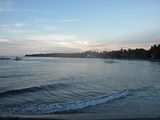
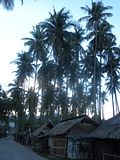
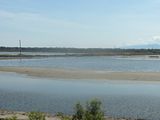
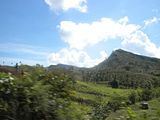
Our original plan was to make an early ferry from Bacolod to Iloilo but as always while backpacking, transportation was unpredictable. The bus took until 2 PM to get us to Bacolod (an hour and a half later than it was supposed to) and on top of that all the ferries were booked out until 3:30 PM. We didn’t get into Iloilo until after 5 PM where (due to the rain that had started) we tried hunting for a guesthouse. The first two guesthouses in our Lonely Planet were booked out completely. What the…? It wasn’t even high season yet! We then asked two cops for some help getting a taxi, but it was useless. Due to the rain, everything was full! After 15 minutes standing around in the rain we gave up and started walking again. Anyways we luckily found the Riverside Inn, an extremely dumpy (I spotted 2 cockroaches upon walking in) and gross place but it was a roof over our heads for the night. Henk ordered us some Pizza Hut to snack on for dinner and tried to find us a better place to stay but everything really was booked out. (Well, everything in our price range at least!)
Henk also had confirmed with our guide for the next morning, Daisy, and her husband Rauel that they would meet us around 8:00 AM. We had a flight to catch from Iloilo to Cebu that night at 7 PM they promised to drop us off at the airport for, so we would be in for another long day. We had read about Daisy in the Lonely Planet and contacted her for a tour to the local Ati tribes people. While I waited for Daisy, Henk went off to get breakfast at a nearby sandwich bar. It took him a long time, even though he told me later he had claimed he needed to catch a flight in order to skip the line. When he finally made it back we were on our way. Daisy offered us snacks after she picked up and made sure we were comfortable in their car. Furthermore, she explained to us some interesting things about Filipino culture along the way.
A good description from the CJMI Ministry website:
“The Ati people of Panay Island are the best known of the Filipino Negritos (Spanish term of Ati). This indigenous tribe is credited with welcoming history's first Malay from Borneo in the fourteenth century. The Ati have retained their dialect with traces of the ancient terms of "Kinaray-a" and dialects of the present time "Hiligaynon."
Unfortunately, the Ati people are often discriminated against due to their dark-skinned appearance and lack of education. As a result, many women and children are forced to work menial jobs in order to survive. This lifestyle perpetuates the lack of education among the Ati youth, making it extremely difficult to break free from the depressed socio-economic class in which they now reside.”
The Ati used to be a nomadic people, but eventually were forced to settle down and intermarry with Catholics. There are still some Ati, many who become street beggars, who remember the old culture, stories, and traditions of their people. Daisy let us know that it was difficult for the Ati to maintain their traditional ways, but since they have stayed relatively secluded (mostly because they are too poor to travel much of anywhere) they do a bit better at culture preservation than other tribes. In fact, the Ati are so poor than none of the children we spoke to had even been to a Robinson’s Mall or had tasted the local fast food Jollibees! Makes sense, because their parents only earn about $3 USD a day by farming rice for their own consumption… leaves them with very little funds for such luxuries as malls!
Our first stop was at a market (where we got many stares and positive compliments on our looks!) where we bought some fish, fruits, etc. for lunch later. While the Ati would want to prepare our meal for us, there was no way they’d be able to afford to buy us meats. Daisy informed us however that the people were nervous about what to offer us… they always try to offer something to guests who come to the village. Well, we thought, if they are so concerned about offering us something we should bring them something as well! Henk and I decided on a basketball for the children, hoping they would have a court to use it on. Daisy bought some fish, pineapple, oranges, shrimp, and other seafood.
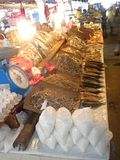
When we reached Nagpana’s (the village’s name) entrance at 10:00 AM we were immediately swapped (with all our food and gift goodies) into a tricycle for the rest of the ride. The name ‘Nagpana’ literally means ‘He shot him with a bow and arrow’ and it comes from a local story about two Ati brothers that went like this: Two brothers and the eldest brother’s wife go out hunting. The oldest brother goes off and leaves his wife with his younger brother. When he comes back he finds out that his wife had been raped by his younger brother. To get back at his younger brother, the older brother shoots him with his bow and arrow. This somber story is actually true, occurred in the village of the Ati people, and is the source of the village’s name.
Henk ended up sitting on the top of the trike since he was so tall! It was an extremely bumpy and steep ride to the village proper and I would have been very worried if I knew that Henk was sitting up there taking pictures instead of hanging on! (Disclaimer by Henk: hehe!) Once we entered the village we were greeted by… well basically all the villagers that weren’t working! Dozens of children looked up at us with curious eyes while their parents smiled and watched us from afar while working on their weaving or other crafts. We headed to the ‘common area’ which was mainly used to receive guests and display the village’s hand-made items.
It was there that we received our ‘offering’ from the village – a large bowl of steamed cassava roots. While it might not seem like much, I’m sure it was meaningful to them to offer us food when they live off of so little themselves. In return, Daisy handed out cookies and crackers she brought with herself for them to snack on. Henk spotted the children and thought it was a wise time to whip out our gift for them. Immediately upon seeing the basketball we had for them, a young boy quickly made his way towards us and claimed it for everyone excitedly. His eyes lit up as he held it and he ran right off to show it to the other kids. We found out later that while the Ati people did in fact have a basketball court, they actually didn’t have a ball to play with since their old one had died! This made us feel extremely glad we had chosen to bring the ball for them. Now they’d have something to do on the basketball court besides hang-out!
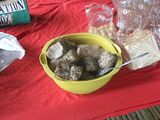
Daisy showed us the tribe’s loom which they sometimes use to weave on, but most of the people had regular T-shirts (although very old and dirty ones) so we figured they didn’t do that much anymore. As we sat in the common area we were able to see the children in the river below us and many women (both young and old) washing clothing a little further down the river as well. While we were sitting and talking to Daisy we noticed more and more people coming out to the common area to hang out. Daisy explained to me that it had gone around the village that we were here and apparently many were coming to see the ‘beautiful girl’ who had arrived. Wow… what a compliment! We made sure to get a bunch of pictures with them which they were really excited to be in with us. One of the little girls even had a head full of curls that looked a lot like mine! Awesome.
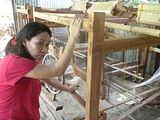

Since it was almost lunchtime we ventured outside to see how the Ati woman preparing our lunch was doing. She was getting the fire started and we realized she would be cooking everything on open wood. Nice and basic. As a final result, we got a great table full of steamed seafood, their local mountain rice (which was really good by the way and I am not a big fan of rice!) and steamed veggies and roots. We even got to sample some of their tribal sweet honey which Henk thought was so great that we bought half a bottle to take with us. During lunch Daisy explained how the Ati were descendants of the Negrito people that had made the land crossing from Africa (when that was still possible) to the Philippines of today. The pure blooded ones are much darker than their fellow Filipinos and have curly hair. However, since intermarriage with the non-Ati is a little more commonplace the curls are slowly disappearing. Sad!!!
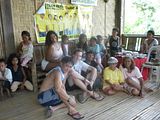
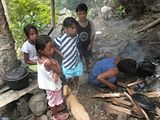
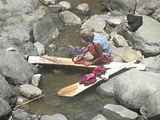
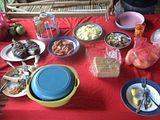
She also told us a story about how a Western guy she knows asked her if it was OK to send money to a Filipino girl for her family’s schoolbooks they need. He hadn’t met the girl in person yet, only spoken to her on the Internet. She explained to us how many young lower class Filipino girls (the middle and upper class usually find Filipino husbands) hunt for older Western men to take care of them and their entire family, relying on milking them for as much $$ as they can for the benefit of their family. Henk and I read in a great little ‘Guide to the Philippines’ earlier that Internet Cafes in the Philippines are just lined up with Filipino women searching for their Western meal ticket… and when we got to the malls and walked around we saw it in action! There were many old guys walking around with young, mildly attractive, Filipino girls – the girls using them for their money, the guys for their looks. Well, at least they are both being used by each other! For a moment I wondered why the Ati didn’t try to do this to escape poverty until I realized that on their daily budget they can’t even afford to take the jeepney to the mall, let alone use an hour of Internet.
After we finished eating Daisy took us on a tour through the village, stopping first to show us the Ati’s little vegetable garden. The first house we came upon wasn’t exactly a house – yet! We found a family working on building a home for themselves out of the bamboo and materials from the forest around them. The ground they were building on was quite sloped, and thus they had to compensate for the incline with their careful building technique. It still looked like they had a long way to go, and they said they had already been working on the house for over a month! We stopped to chat with them a while and ask a few questions about their new home.
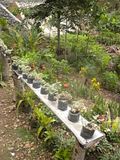
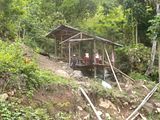
It seemed like every time we stopped to ask a few questions we gained another curious child or two who would then continue to walk with us the rest of the way. At one point a bunch of the children climbed up the trees showing us their skills at picking fruit from high up. They brought us back tons of green mangos which we thankfully piled into Daisy’s backpack for later. They kept bringing more fruit until we insisted we had plenty! While the kids were bringing us fruit, Henk was getting a slingshot lesson from Erlino Elosendo, one of the local tribesmen. He showed Henk how to aim and shoot down fruit from the trees far above us. Next we made our way up another hill to Erlino’s house to meet his family and get a peek inside their home. Wow, did they live simple! But they were blessed with a spectacular view from their home.
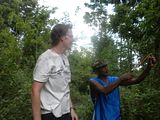
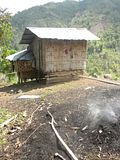
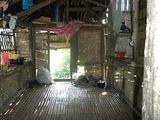
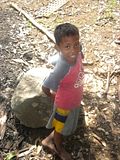
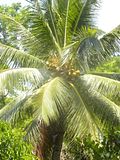
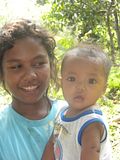
We noticed a little fire burning outside and Daisy explained that they were burning wood to make charcoal to sell using a careful method that keeps the fire going for a long time. While we explored and had some fun with the kids who continued to follow us, the tribesman shimmed up a nearby coconut tree and brought us back another snack! Wow, we were really stuffed by now but as a guest we’d hate to decline. (And come on, he just climbed a coconut tree for us!)
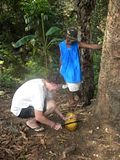
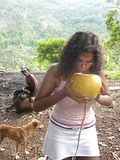
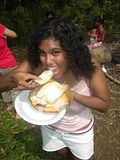
Henk, Daisy, and I went into the rice planting fields next and saw a few men and women hard at work in the scorching sun. I really have to admire their ability to withstand the heat and do hard labor under it! It was here that we met Helenita Asagada, the women you see pictured here who explained to us the finance behind their work. Even though they usually can’t afford to sell their rice (as they consume it instead) when they do it is for less than 50 cents per kilo. While we continued our walk we learned about a creation story believed by the Ati people and some other tribes in the Philippines. The Ati believe that the first ‘Adam and Eve’ were born simultaneously from two bamboo shoots.
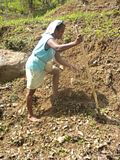
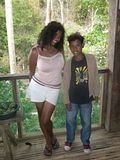
By the time we got back down to the bottom of the village, finishing up our walk, Henk and I had been attacked by mosquitoes and needed something to quell the itching. We had run out of anti-itch cream, but it was actually a blessing in disguise. Just like in Sapa, we got to try a local method of pain relief instead of our typical Western method. But this time the result was more successful! Once we explained to the Ati that we were itching, they showed us a leaf right in front of us locally known as, ‘kakawati’ or otherwise known as ‘madre de cacao.’ They had us grab the leaves off the bush and crush them with our hands, rubbing the juice that seeped out of them onto our skin. I didn’t expect much from this method but I was pleasantly surprised that the itching actually stopped! It worked!
It was now sadly time to say goodbye to everyone. Henk and I had picked out a few of their handicrafts (a cute little handmade purse and some bracelets) earlier and paid them what is equivalent to a couple days’ wages to thank them for their hospitality. We gathered these up along with our backpack and headed back to the tricycle for another bumpy ride back to the car. Upon getting back we realized something dangerous: Rauel had left the lights on in the car! Thankfully the battery hadn’t died and we were able to drive away, waving goodbye to many of the children and people we met that day.
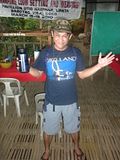
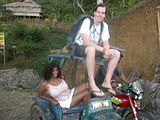
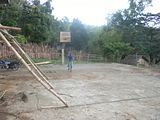
Oh, good side-note! On the way back to Iloilo Henk and I requested to stop quickly at a little market we saw on the way to the village because we saw a really cool dress for me! It was bright and colorful, with a neat hood and slim-fitting. Most of all really cheap! Can’t get cool dresses like that for $5 USD back home… While we drove back Daisy showed us the clothes she bought for her and Rauel’s daughter. When we asked her what her daughter’s name was she laughed and told us it was ‘Dayselle’ a name they had created for her by combining both their (Daisy and Rauel) first names.
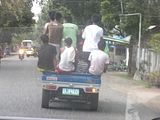
Anyways we got to the airport early only to find out that their computers were down and they would have to check-in everyone by writing things down. (what did I tell you about reliable transportation! LoL! Don’t count on it!) This made the check-in process insanely slow. After we endured a quick flight back to Cebu, and overnight stay in a little hotel near the airport, and a flight out to Puerto Princesa the next morning we were on our way to a new island in the Philippines!
Francesca
